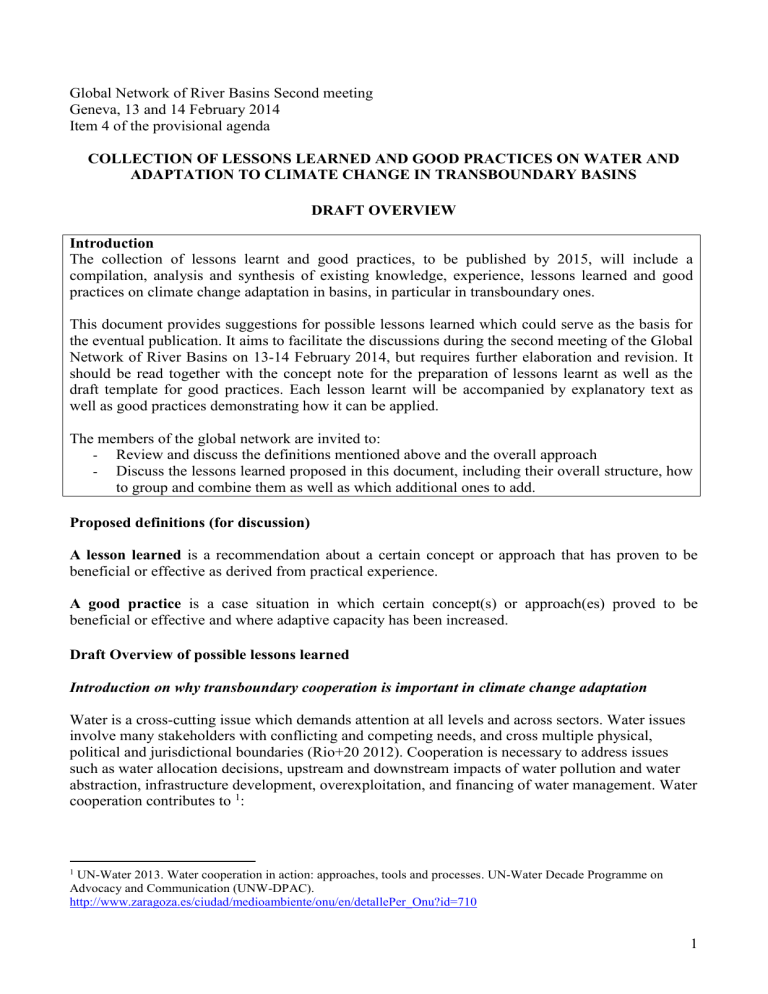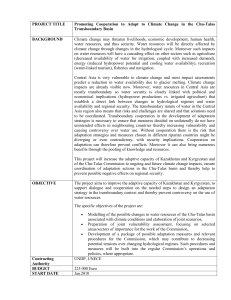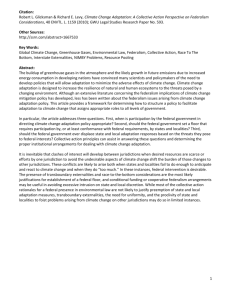UNECE Water and Climate Task Force

Global Network of River Basins Second meeting
Geneva, 13 and 14 February 2014
Item 4 of the provisional agenda
COLLECTION OF LESSONS LEARNED AND GOOD PRACTICES ON WATER AND
ADAPTATION TO CLIMATE CHANGE IN TRANSBOUNDARY BASINS
DRAFT OVERVIEW
Introduction
The collection of lessons learnt and good practices, to be published by 2015, will include a compilation, analysis and synthesis of existing knowledge, experience, lessons learned and good practices on climate change adaptation in basins, in particular in transboundary ones.
This document provides suggestions for possible lessons learned which could serve as the basis for the eventual publication. It aims to facilitate the discussions during the second meeting of the Global
Network of River Basins on 13-14 February 2014, but requires further elaboration and revision. It should be read together with the concept note for the preparation of lessons learnt as well as the draft template for good practices. Each lesson learnt will be accompanied by explanatory text as well as good practices demonstrating how it can be applied.
The members of the global network are invited to:
-
-
Review and discuss the definitions mentioned above and the overall approach to group and combine them as well as which additional ones to add.
Discuss the lessons learned proposed in this document, including their overall structure, how
Proposed definitions (for discussion)
A lesson learned is a recommendation about a certain concept or approach that has proven to be beneficial or effective as derived from practical experience.
A good practice is a case situation in which certain concept(s) or approach(es) proved to be beneficial or effective and where adaptive capacity has been increased.
Draft Overview of possible lessons learned
Introduction on why transboundary cooperation is important in climate change adaptation
Water is a cross-cutting issue which demands attention at all levels and across sectors. Water issues involve many stakeholders with conflicting and competing needs, and cross multiple physical, political and jurisdictional boundaries (Rio+20 2012). Cooperation is necessary to address issues such as water allocation decisions, upstream and downstream impacts of water pollution and water abstraction, infrastructure development, overexploitation, and financing of water management. Water cooperation contributes to
1
:
1 UN-Water 2013. Water cooperation in action: approaches, tools and processes. UN-Water Decade Programme on
Advocacy and Communication (UNW-DPAC). http://www.zaragoza.es/ciudad/medioambiente/onu/en/detallePer_Onu?id=710
1
•
Poverty reduction and equity; More inclusive governance of water and cooperation between different users can help overcome inequity in access to water, which is essential for satisfying basic human needs and reaching the Millennium Development Goals.
•
Economic benefits; Cooperation can lead to more efficient and sustainable use of water resources, e.g. through joint management plans creating mutual benefits and better living standards.
•
Preserving water resources and protecting the environment; Cooperation facilitates the exchange of data and information and can help develop joint management strategies to preserve water resources and protect water-related ecosystems.
•
Promoting peace; Cooperation on water can help overcome cultural, political and social tensions and build trust between communities, regions and states.
…
1.
Legal and institutional arrangements (formal and informal)
1.1.
Demonstrate the importance and usefulness of basin-wide adaptation.
Identify the mutual dependencies on the water resource and possibilities for cooperation.
Also identify the economic benefits as well as (potential) cultural, political and social benefits. …
1.2.
Ensure that each adaptation policy considers climate change as one of many anthropogenic pressures on water resources.
Text to be developed …
1.3.
Involve decision-makers in the adaptation process from the beginning to ensure that the process is connected with policy making.
Text to be developed …
1.4.
An institutional structure is essential to ensure cooperation between riparian countries in climate change adaptation.
A joint body and joint basin management can be the means to deal with adaptation.
Alternatively, a mandate can be created by a governing body, e.g. by the ministerial conference. Existing joint bodies should have/get the mandate to deal with adaptation. …
1.5.
Build transboundary teams among scientists, administrative authorities, experts to enable joint assessments.
A joint group to harmonise the tools, the methods, the models and scenarios to be used is a good way for preparing a basin-wide vulnerability assessment and adaptation in general.
Such groups should include representatives of all riparian countries as well as different regions and sectors of basin-wide relevance.
A proper exchange of information between the countries is imperative for this. A stakeholder analysis can help to identify persons to be involved. A thorough baseline study is needed to identify ongoing adaptation projects, strategies, laws and policies in the riparian countries. …
1.6.
Design transboundary agreements in a flexible way
Text to be developed …
2
2.
Apply IWRM principles
2.1.
Apply transparency and openness throughout the process.
When working together in a transboundary basin, transparency in methods used, transparency on uncertainties, on interests etc. is needed to ensure the necessary mutual trust. …
2.2.
Ensure stakeholder participation in all steps of the development and implementation of adaptation strategies and measures.
Interest of civil society needs to be developed for this. …
2.3.
Incorporate the ecosystem approach into adaptation strategies.
The ecosystem approach is often relatively cheap and cost-effective. Increasing ecosystems’ resilience can be done by including the ecosystem as ‘water user’ through environmental flows. Healthy freshwater ecosystems often have high natural resilience, can resist extreme events, and a transition into new ecological conditions can take place. “Hard” water infrastructure usually restricts or eliminates some of this natural resilience. Soft or “green” infrastructure to manage water can help combine control of water resources, restore flow regimes, and rebuild natural climate resilience. Ecosystem-based adaptation has positive effects in addition to the direct effect on adaptation, such as improving the livelihoods of people. Ecosystem-based adaptation is particularly relevant in (transboundary) basins which can be considered as one ecosystem and since ecosystem-based adaptation measures can have positive effects for the entire basin. …
2.4.
Ensure synergies and linkages between adaptation actions at different government levels
(local, national, regional, transboundary) and different (economic) sectors.
Text to be developed …
3.
Information and data needed
3.1.
Ensure to collect and share the appropriate and needed data, information, and models from the entire basin and across the water cycle.
This includes quantitative and qualitative local knowledge, paleo records, surface and groundwater monitoring records, projected information (e.g., from the IPCC), extreme event records, supply/demand/usage estimates, data for building climate, socioeconomic, and environmental scenarios, and an elaboration of knowledge base on expected future changes.
In situations where not all data are available incomplete data, alternative sources (such as sometimes remote sensing / satellite data) or expert opinion can be used instead.
To enable sharing of data, a common, integrated, accessible database is needed. Sharing of information and data can be done at small scale at the beginning and then at a larger scale as countries and/or other data holders may initially be reluctant to share data. The various datasets need to be harmonised for scale, data resolution, and focus of data, so that datasets are usefully interoperable. The data included in the database need to be processed for verification, groundtruthing, accuracy and precision, and degree of uncertainty. …
3
3.2.
Evaluate thematic, spatial, and temporal areas of coverage and gaps.
3.3.
Ensure transfer of knowledge from science to decision-makers and the political sphere.
Text to be developed …
This could be realised through a working group composed of decision-makers and scientists.
…
4.
Vulnerability and impact assessments
4.1.
Develop a common understanding about the concepts of vulnerability, opportunity, impact, and uncertainty related to climate change.
Joint assessment of problems, priorities, and solutions is crucial in (transboundary) basins.
…
4.2.
Include all steps of the water cycle in the vulnerability assessment.
This includes precipitation, runoff, groundwater recharge, and a wide variety of water variables (e.g., quantity, quality, and seasonality). …
4.3.
Cooperation with neighbouring countries in scenario- and model elaboration and data exchange helps to use a wider range of models and scenarios and achieve higher credibility of predictions thanks to more data.
Text to be developed …
4.4.
Harmonize the use of climate, environmental, and socio-economic models and scenario development.
To this end, national models can be linked together and compared. Ideally, basin-wide models and scenarios should be created. …
4.5.
With stakeholder and decision maker engagement, performance markers/indicators of success/failure.
Text to be developed …
4.6.
Establish mechanisms for regularly updating the assessments, the scenarios of changes, and the implication on water resources in order to ensure flexible adaptation.
Text to be developed …
4.7.
Combine the vulnerability assessment with concrete measures and actions on the ground that increase adaptive capacity. e.g., low or no-regret measures for example for floods of droughts …
4.8.
Reconcile uncertainty and confidence in recommendations and strategy in the assessment results.
Text to be developed …
4
5.
Developing and prioritizing adaptation measures
5.1.
To deal with the uncertainties of the data and information about climate change, an adaptive approach towards implementing measures is needed.
Text to be developed …
5.2.
Environmental Impact Assessment (EIA) and Strategic Environmental Assessment (SEA) can provide an institutional and legal basis for climate change adaptation.
Text to be developed …
5.3.
Develop a mix of structural and non-structural measures.
Text to be developed …
5.4.
Prioritize the adaptation measures.
Prioritization can be based on the vulnerability assessment and cost-benefit analysis as well as other decision-making tools such as the AGWA Decision Support System and other similar tools. Such tools and their results should be sufficiently simplified for policy-makers in a short document …
5.5.
Involve other sectors for defining adaptation priorities.
This can be done, e.g., through multi-stakeholder workshops; look for synergies with the
Adaptation plans of other sectors (energy, agriculture, etc.) …
5.6.
Assess the economic, environmental and social costs and benefits of different adaptation options.
Text to be developed … Include transboundary costs and benefits. …
5.7.
Consider linkages and integration with adaptation efforts at other management levels
Assess the potential transboundary effects of national and lower-level adaptation options.
Mainstream transboundary adaptation measures e.g. in national climate change strategies etc. and vice versa. Also share information on national adaptation strategies and their implementation in the process of developing an adaptation strategy. Also consider which issues need to be addressed at the transboundary/ basin-wide level: e.g. agriculture, ecosystems, infrastructure- and which issues, in contrast, do not require basin-wide coordination or action. …
6.
Financial and economic matters
6.1.
Integrate the cost / benefit analysis and the financial mechanisms linked to the decision process.
Financial issues form an important part of the decision making process. One important element is to perform an initial approximate economic evaluation of the climate change
5
impact on water resources in the basin in order to convince decision-makers about the need to act. Further on in the process economic instruments and financial mechanisms can help to address the risks and the uncertainties. …
6.2.
Ensure financing of the adaptation plan through a mix of public & private funds.
Text to be developed …
6.3.
In a transboundary basin, it can be more beneficial to locate adaptation measures in another part of the basin and share costs thereof.
Text to be developed …
7.
Evaluation of adaptation strategies
7.1.
Implement concrete (low or no-regret) adaptation measures while continuing to monitor, evaluate and further develop the strategy.
Text to be developed …
8.
Capacity development
8.1.
Identify the need for capacity development and develop a capacity development plan accordingly.
Particularly capacity development in non-water areas, like planning, uncertainty management, forecasting, scenario development, etc. at the basin level may be needed. …
8.2.
Use education to raise awareness on the need of adaptation.
Text to be developed …
8.3.
Exchange knowledge and experience between stakeholders on the adaptation activities to learn and build capacities.
Text to be developed …
9.
Communication and stakeholder involvement
9.1.
Stakeholder participation supports development of measures that take account of the local conditions.
Text to be developed …
9.2.
Involve local communities at the border.
Text to be developed …
9.3.
Develop an effective communication on the adaptation to climate change and the related uncertainties.
Proper communication is a means to translate technical/ scientific vulnerability/ impact assessment towards institutional governmental changes. …
6









